Millions of Indians are gaining free access to AI in India, creating the largest adoption wave the world has ever seen. With 900 million internet users and the lowest mobile data costs globally. India has become the most dynamic testing ground for new AI behaviour. These giveaways are not acts of generosity. They are strategic moves designed to build habits, train models, and shape future pricing patterns.

As someone working across media, digital transformation, and new technology, I have seen how fast these shifts move. At TrendVisionz, our continuous research and work with high-ticket clients keeps us close to how AI influences real decisions. AI has become a major part of our workflow, but it strengthens our teams instead of replacing them. The real value still comes from a human brain powered by AI.
The AI story is no longer West-led. It is co-authored by Big Tech and India’s inclusive digital vision. Read till the end to discover how this partnership in AI is quietly rewriting the future for the world’s fastest-growing digital economy.
Also Read:
- AI & Robotics: How Early Integration Is Shaping Modern Healthcare
- From Arts to Commerce: How AI in Education Shapes Every Student’s Future
India: The World’s Largest AI Testbed
India is moving through a tech shift that many countries may never experience. With 900 million internet users, 97 crore mobile connections, and the lowest data costs globally, the country has become the most active testing ground for AI in India. Scale and curiosity meet here every day.
Why India behaves differently from other markets
India’s digital space feels more open than China’s restricted environment and more flexible than the EU’s heavy regulatory structure. People explore tools faster and abandon them just as quickly. In our TrendVisionz’s agency research work, we see users adopt new apps long before global trends appear. This behaviour shapes how AI companies design and refine their models.

As companies study how Indians try, switch, and stress-test new tools, they also look deeper at the systems that make this behaviour possible. Fast adoption is one part of the story. The real advantage comes from India’s underlying digital foundation.
How do GPUs strengthen India’s role in global AI?
GPUs are the machines that power modern AI. They handle thousands of calculations at the same time, which makes them perfect for running and training large models like ChatGPT, Gemini, and Llama.
AI needs compute. GPUs are compute. India is scaling compute.
Every AI response you see online is processed through GPUs. India’s rapid AI growth depends on expanding this compute layer.
What gives India a unique AI advantage
India’s real AI advantage goes beyond fast user behaviour and growing compute power. India’s strength in AI comes from a digital ecosystem built on trust and habit. Millions use UPI, Aadhaar-authenticated services, and app-based workflows daily. This gives AI companies a stable foundation to test behaviour across diverse settings. India’s AI ecosystem grows because several real factors come together. Here are the three that matter most.
- Digital public infrastructure builds trust. UPI, Aadhaar, and ONDC train people to use tech daily.
- Youth adoption drives speed. With 65 percent under 35, changes spread fast and naturally.

Global companies study Indian users closely because behaviour here moves faster than in most markets. They track how people search, switch apps, test features, respond to pricing, and use AI across languages. These patterns help companies predict demand with far more confidence. As Tarun Pathak from Counterpoint Research said,
“The plan is to get Indians hooked before asking them to pay.”
This insight explains why India often becomes the first place where AI rollouts are tested, adjusted, and expanded. And once that behaviour is mapped, it opens the door to understanding how AI systems learn at scale
How Indian behaviour trains global AI
AI systems learn from behaviour at scale. When millions interact with free AI tools, patterns form fast. The way Indians search, experiment, shift platforms, and test new features helps AI understand real human behaviour across languages, regions, and intent types.
India’s scale, openness, youth base, and constant digital experimentation make it the world’s richest AI learning ground. What AI learns here often shapes how global models evolve next.
Key Facts from the IndiaAI Mission
India’s AI ecosystem is expanding faster than most global markets. GPU access under IndiaAI starts at 65 per hour, less than one dollar, making compute far more affordable for developers. These numbers show how quickly the foundation for IndiaAI is strengthening across infrastructure, skills, and partnerships.
- Over 38,000 GPUs available nationwide through public–private partnerships at low cost.
- More than 2,800 datasets accessible on the AIKosh platform for model training.
- Twelve Indian entities building indigenous foundation models, including voice-first LLMs.
- India ranks second globally in GitHub AI project contributions.
- More than 6,000 active AI startups, with over half of all tech funding going to AI.
- Over twenty global MoUs signed for AI and digital cooperation with Global South nations.
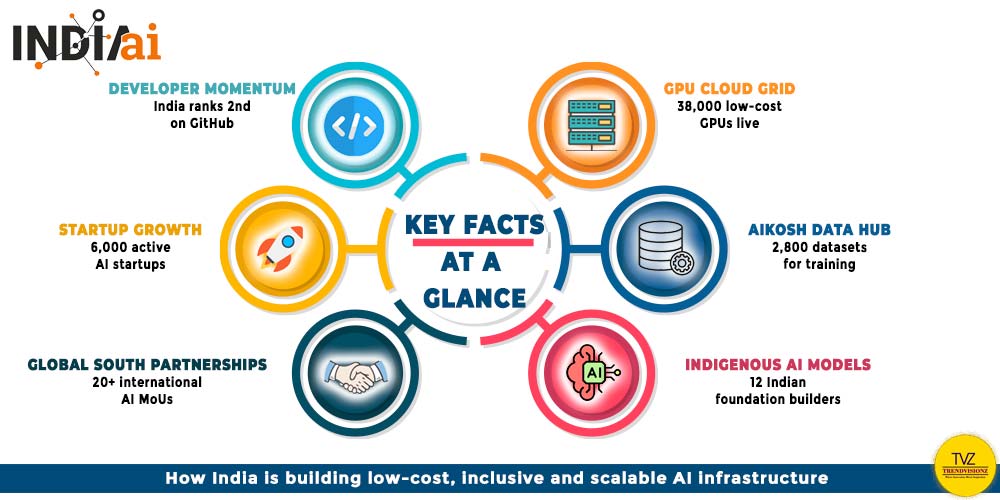
These facts show India’s clear push to build an AI ecosystem that is affordable, inclusive, and built for real-world needs.
The Great AI Giveaway: Big Tech’s Freemium Playbook
Free AI access isn’t generosity. It is a carefully designed strategy to build habits, capture attention, and create long-term demand. India’s scale makes this strategy even more powerful, because behaviour forms fast when millions try something at once.
The rollouts that changed everything
In the last year, India has seen an unusual wave of AI offers.
- ChatGPT Go made free for 12 months, waiving the ₹399 monthly plan.
- Google Jio AI Pro bundled into new 5G plans for 18 months.
- Perplexity Pro Pack valued at ₹17,000 offered free to Airtel users for one year.

These are not discounts. They are pipelines. Every free access point feeds engagement, creates behavioural loops, and helps companies refine their models. Once users get used to AI, monetization becomes easier and more predictable.
Why early warnings matter
AI was evolving fast, and the early systems were improving quietly in the background. Most people didn’t realise how quickly it would scale or how much influence it would gain. Even today, we see signs of that early concern in India’s rapid adoption. In 2017, Elon Musk issued a caution about the speed of AI progress and the need for proactive oversight.
AI is a rare case where we need to be proactive in regulation instead of reactive – Elon Musk
His warning feels more relevant now. As AI companies push aggressive freemium models, the pressure on governments to regulate data use, transparency, and model safety grows. India has already taken a step in this direction with the DPDP Act and plans for the IndiaAI Safety Institute.
Privacy and the new compliance landscape
India’s DPDP Act 2023 is not fully enforced yet, but the direction is clear. Users often accept convenience over caution, and that behaviour requires guardrails.
“Users trade data for convenience; regulation must evolve.” – Prasanto K Roy, Public Policy Analyst
Other countries move differently. The EU demands strict consent for AI usage. On the other hand Korea requires AI-labeled outputs. India is choosing a lighter but more adaptive approach, balancing access and safety.
India’s AI giveaway builds habits, creates massive datasets. It eventually prepares the ground for a new wave of personalized AI products. The companies that understand this loop will shape the next decade of digital behaviour.
IndiaAI Mission: Building the Nation’s AI Backbone
India’s AI future cannot depend only on Big Tech rollouts. While global companies drive early adoption, India is building something deeper. The government is investing to own the infrastructure behind intelligence itself. This shift changes how the country will build, train, and scale AI in the years ahead.
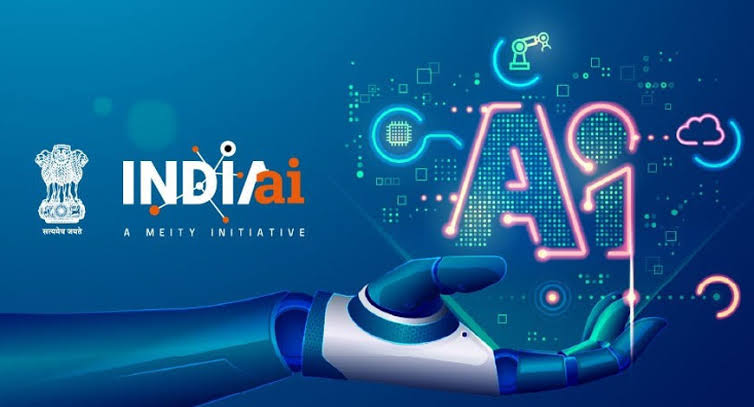
The investment that sets the foundation
In March 2024, the Cabinet approved the IndiaAI Mission with a national outlay of 10,372 crore (Approx 1.25 billion dollars), committed over five years. The plan includes 38,000 GPUs available through a public-private compute grid. Low-cost access will give students, startups, and researchers the tools they need to build next-generation models.
Speaking at a national technology roundtable in Bengaluru, the Minister explained how future AI systems will strengthen India’s digital economy and improve governance.
AI will be kinetic enabler of India’s digital economy and also make Governance smarter and more data-led – Rajeev Chandrasekhar, Former Minister of State for IT
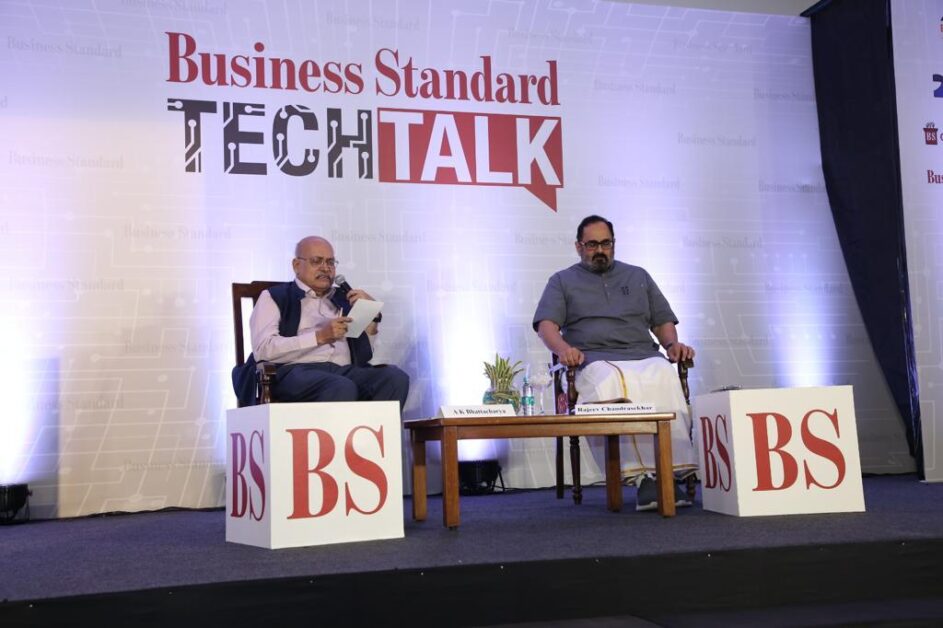
This vision goes beyond tools. The mission aims to expand compute infrastructure and ensure ethical guardrails. It signals that India views AI as both an economic engine and a public good, guiding long-term innovation across the country.
The seven pillars of the IndiaAI Mission
India’s AI growth needs more than access to tools. It needs structure, skills, and a national plan that brings every part of the ecosystem together. These seven pillars reflect exactly that. They create the foundation India needs to build, train, and scale AI responsibly.
The mission is structured around seven core pillars that touch education, research, startups, governance, and safety. Here is the full stack.
- Compute: A distributed grid of 38,000 GPUs available at affordable hourly rates.
- Application development: Thirty new AI projects across health, agriculture, climate, and education.
- AIKosh datasets: A national repository with three thousand datasets and more than two hundred models.
- Foundation models: Support for India-built models like Sarvam AI, Gnani AI, Gan AI, and Soket AI.
- FutureSkills: Training for thirteen thousand five hundred AI fellows and twenty-seven labs in Tier-2 and Tier-3 cities.
- Startup financing: Global access through IndiaAI Startups at hubs like Station F and HEC Paris.
- Safe and trusted AI: A dedicated focus on bias testing, risk evaluation, and an AI Safety Institute.
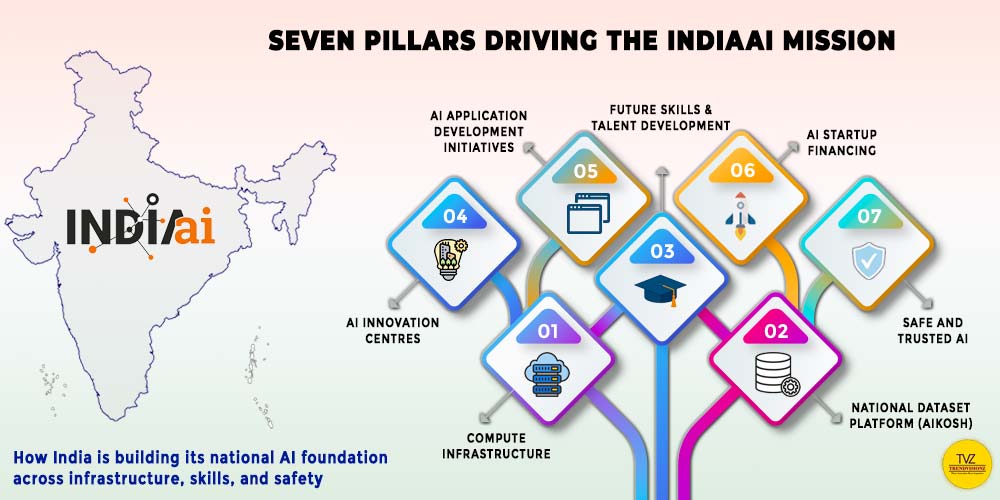
“IndiaAI is building more than infrastructure. It is creating a multilingual, affordable, and inclusive AI ecosystem that reflects the needs of India and the Global South, giving local innovators the tools to shape intelligence for the world.”
These pillars show how India plans to grow AI with balance—building infrastructure, expanding talent, and ensuring safety.
How India compares with the United States
The United States leads the AI landscape with nearly 29,000 AI companies. A growing market size above 70 billion dollars, and cloud projects like Amazon’s Rainier running almost half a million specialised chips.
By 2026, global robot installations may reach 5.5 million, driven largely by U.S. capability. India cannot match this scale, but it offers something unique. Low-cost compute, public digital infrastructure, and broad access create a more democratised innovation model that pulls millions into the AI ecosystem.
A model built on innovation with integrity
India’s approach balances infrastructure, access, and ethics. The goal is clear. India wants growth, but not at the cost of safety or fairness. This puts the country on a different path from markets driven purely by commercial competition.
India is not chasing the West. It is building an AI model rooted in accessibility, affordability, and accountability. This foundation will shape how India builds intelligence for the next decade and beyond.
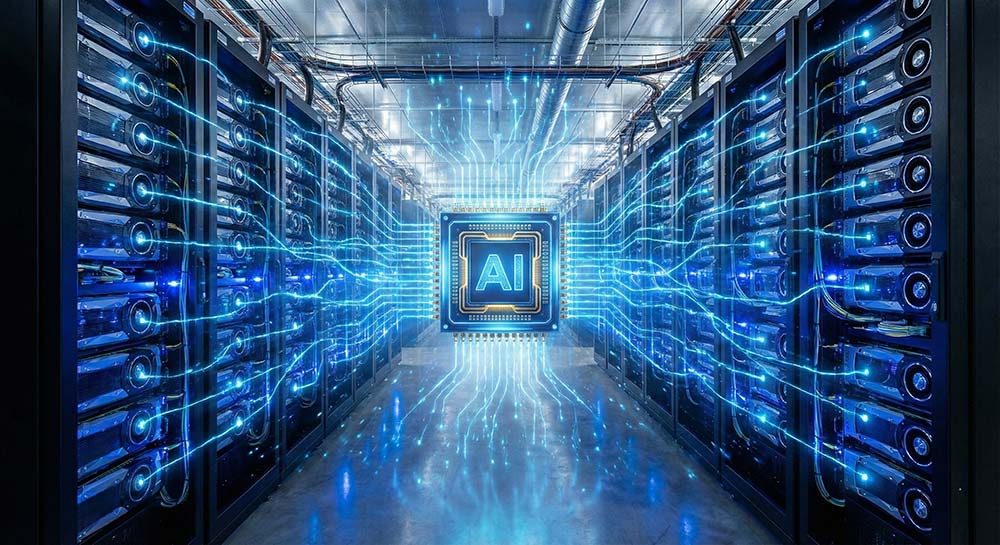
From Labs to Lives: India’s AI Revolution in Action
AI in India is no longer limited to labs or pilot programs. It has moved into classrooms, clinics, farms, and even district courts. The impact feels real because adoption is happening across diverse groups and regions, not just in urban technology circles.
1️⃣ Education: Changing how students learn
India’s classrooms are already experiencing early shifts. The CBSE AI curriculum introduced under NEP 2020 has taken AI literacy to millions of students. The YUVAi initiative encourages schoolchildren to build real AI projects. Platforms like DIKSHA help teachers personalise lessons, making content accessible across languages and learning levels.
Three changes stand out.
- Students interact with AI-driven learning tools much earlier.
- Teachers gain better insights through digital assessments.
- Government platforms bridge gaps for rural and remote learners.
2️⃣ Healthcare: When AI meets public health
India’s public health systems are seeing measurable improvement. HealthAI projects built with ICMR, Singapore, and UK partners are being tested to support diagnostics. Telemedicine is scaling fast. More than one lakh consultations have already been delivered through e-Sanjeevani, showing how AI and digital health together increase access in underserved regions.
3️⃣ Agriculture: Better decisions for farmers
AI tools now assist farmers with crop monitoring, soil recommendations, and early disease detection. Services like Kisan e-Mitra and AI-based weather models help farmers plan better. These small technology layers reduce risk and improve productivity, something we hear often from our research circles and client interactions in rural-focused sectors.
4️⃣ Startups and global recognition
India’s startup ecosystem shows how deep AI adoption has become. The country has 1.8 lakh startups, and almost 89 percent use AI in some form. There are more than five hundred global capability centres focused on AI and data. India now ranks among the top four countries for AI skills, according to the Stanford AI Index 2025.
AI’s economic impact 1in India is also becoming clearer. A recent report estimated a potential 450 to 500 billion dollar value unlocked by AI across nine major industry sectors by 2025.
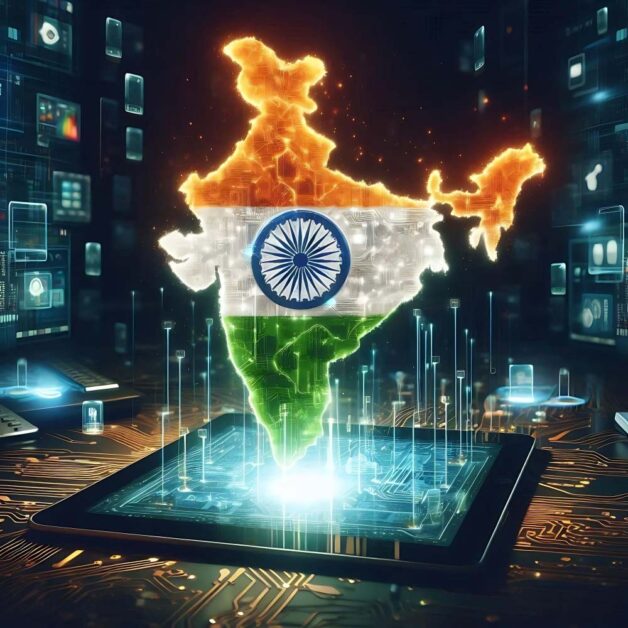
5️⃣ Cultural and economic impact
AI is also bridging India’s language and literacy divide. Platforms like Bhashini support twenty languages, helping more people interact with digital services, government platforms, and basic information. India’s policy vision for AI also emphasises public good. A NITI Aayog roadmap2 highlights how AI can drive inclusive growth through targeted, socially focused interventions
AI in India is not future talk. It has become everyday utility. It is shaping skills, jobs, decisions, and opportunities across the country, creating a more inclusive and data-aware society.
Also Read:
- SEO Is Dead? How AI Search Is Evolving User Behaviour
- Saiyaara Song’s AI Twist: How Kishore Kumar’s Voice Was Digitally Recreated
FAQs: AI in India
What is the DPDP Compliance Act?
India’s Digital Personal Data Protection Act 2023 sets rules for how organisations collect, store, and use personal data. It focuses on consent, purpose limits, and safeguards. AI-specific rules will be added once MeitY releases the final regulatory framework.
What is the 30 Percent Rule for AI?
The 30 percent rule requires government AI projects to source at least one-third of datasets, compute resources, or development support from domestic providers. The goal is to strengthen sovereign control, ensure data integrity, and build India’s long-term AI capability.
How will AI be regulated in India?
AI in India will be regulated through the DPDP Act, sector guidelines, and the upcoming IndiaAI Safety Institute. The framework will focus on light-touch oversight, transparency, bias checks, and accountability standards while allowing innovation and public access to grow.
Conclusion
India’s AI journey is entering a defining phase. The Great AI Giveaway shows how Big Tech shapes behaviour, while IndiaAI builds the infrastructure that will sustain long-term innovation. This shift moves India from being a passive user of technology to becoming a creator in the global AI ecosystem. Real impact will come from inclusive access, responsible policy, and local innovation. AI in India is no longer a promise. It is becoming a daily force that shapes work, learning, and opportunity.
Follow TrendVisionz for deep insights on IndiaAI, emerging technology, and the ideas shaping our digital future.
Additional Resources:
- NASSCOM. (2023). AI Adoption Index: India’s AI Opportunity. https://nasscom.in/ai-adoption-index/ ↩︎
- NITI Aayog. (2025). Roadmap on AI for Inclusive Societal Development. https://niti.gov.in/sites/default/files/2025-10/Roadmap_On_AI_for_Inclusive_Societal_Development.pdf ↩︎
Stay Connected with Me
Anshuman Mahajan is a Digital Marketing Strategist, SEO Specialist, and Co-Founder of TrendVisionz. With expertise in ROI-focused growth strategies, brand development, and media solutions, he helps businesses navigate the fast-changing digital landscape with clarity and confidence.
- Explore my work: TrendVisionz | Nuteq Entertainment
- Read our newsletters: BizTech Chronicle
- Guest writer: BizCatalyst360 | Industry Blogs
- Courses & Certification: B.Com (Hons), University of Delhi | Digital Marketing (Shaheed Sukhdev College of Business Studies) | SEO Internship, ClickSlice (London)
- Join the community: LinkedIn Group – Digital Marketing & Content Creation World
- Connect with me: LinkedIn | BizTech Chronicle | #GrowWithAnshuman
- Share your review: Leave your feedback on Google — it helps us grow.
- Subscribe: Be part of our 1.95 Lakh+ YouTube family
Believe. Transform. Succeed. Let’s grow together.

